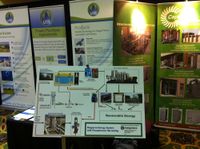UTS Residual Processing
|
WARNING! Sewage sludge is toxic. Food should not be grown in "biosolids." Join the Food Rights Network. |
UTS Residual Processing is a subsidiary of Anaergia, Inc., which, in its own words, develops and provides "technology solutions to industrial, agricultural and municipal customers in the fields of wastewater treatment, anaerobic digestion, biogas capture for energy generation, biosolids handling and waste to value solutions."[1] UTS "provides process design, engineering and proven technology for complete management of organic wastes. UTS' services extend to turnkey anaerobic digestion systems with generation and treatment of biogas, delivering biomethane for energy and heat, vehicle or pipeline use. Treatment of by-products, through proprietary solid/liquid separation methods, provides additional economic and environmental benefits."[2]
Contents
Toxic Sludge Gasification Controversy
"Biosolids handling," "complete management of organic wastes" and "treatment of by-products, through proprietary solid/liquid separation methods" to provide "additional economic and environmental benefits" are all PR spin phrases for Toxic sludge processing and, in the case of "additional economic... benefits," land application of toxic sludge.
EPA whistleblower Hugh Kaufman has called gasification, or using sludge to generate methanol or energy, the "most environmentally sound approach, but also the most expensive," to sludge disposal. However, anaerobic digestion of sewage sludge, while it reduces the volume of the sludge and heats it to a temperature that kills many pathogens, still leaves behind what the industry calls "digestate" or, more specifically in this case, "biosolids." These "Class A Biosolids" (so-called because the Environmental Protection Agency has stricter limits on pathogens and "vector attraction" for Class A than for Class B Biosolids, i.e. they must not attract disease-carrying insects or rodents, etc.) still contain other sludge contaminants, including Dioxins and Furans, Flame Retardants, Metals, Organochlorine Pesticides, 1,2-Dibromo-3-Chloropropane (DBCP), Naphthalene, Triclosan, Nonylphenols, Phthalates, Nanosilver, and thousands more substances.
The EPA's 2009 Targeted National Sewage Sludge Survey (TNSSS) concluded that all sewage sludge, Class A, Class B or otherwise, contains toxic and hazardous materials, including large numbers of endocrine disruptors. The TNSSS results are described in two EPA reports published in 2009. EPA found that dozens of hazardous materials, not regulated and not required to be tested for, have been documented in each and every one of the sludge samples EPA took around the USA.[3] And yet Class A "Biosolids" may be applied to cropland with no restrictions and sold or given away to gardeners as "organic fertilizers," and hundreds of municipalities and companies do so.
Exhibitor at and Sponsor of the 2011 BioCycle 11th Annual Conference on "Renewable Energy from Organics Recycling"
UTS Residual Processing was an exhibitor at and sponsor of the 2011 BioCycle 11th Annual Conference on "Renewable Energy from Organics Recycling." BioCycle Magazine is a publication serving the interests of the sewage sludge industry.[2][4]
Resources
Other SourceWatch Resources
References
- ↑ Michael Theodoulou, P. Eng., R&D Director, Anaergia Inc., Letter to Geordie Gauld, City of London RE: Non-Disclosure Agreement, August 23, 2011
- ↑ 2.0 2.1 BioCycle, Exhibitor Directory, publisher's website, accessed November 3, 2011
- ↑ Environmental Protection Agency, TNSSS: EPA-822-R-08-016 and EPA-822-R-08-018, January 2009
- ↑ BioCycle, 11th Annual Conference on Renewable Energy from Organics Recycling 2011, schedule and sponsors, accessed November 8, 2011
| This article is a stub. You can help by expanding it. |

